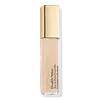What's inside
What's inside
 Key Ingredients
Key Ingredients

 Benefits
Benefits

 Concerns
Concerns

 Ingredients Side-by-side
Ingredients Side-by-side

Water
Skin ConditioningMethyl Trimethicone
Skin ConditioningDimethicone
EmollientTrimethylsiloxysilicate
EmollientLauryl PEG-9 Polydimethylsiloxyethyl Dimethicone
Skin ConditioningPhenyl Trimethicone
Skin ConditioningSynthetic Fluorphlogopite
Polysilicone-11
Silica
AbrasiveButylene Glycol
HumectantCoco-Caprylate/Caprate
EmollientPPG-12/Smdi Copolymer
EmollientTocopherol
AntioxidantSodium Hyaluronate
HumectantCaffeine
Skin ConditioningGlycerin
HumectantEthylhexylglycerin
Skin ConditioningTrihydroxystearin
Skin ConditioningCaprylyl Glycol
EmollientTriethyl Citrate
MaskingAlumina
AbrasiveDisteardimonium Hectorite
StabilisingCI 77120
Cosmetic ColorantSaccharide Isomerate
HumectantLaureth-12
EmulsifyingLecithin
EmollientLaureth-7
EmulsifyingHexylene Glycol
EmulsifyingCitric Acid
BufferingSodium Hydroxide
BufferingSodium Carbonate
BufferingDimethicone/PEG-10/15 Crosspolymer
Sodium Chloride
MaskingXanthan Gum
EmulsifyingDipropylene Glycol
HumectantTriethoxycaprylylsilane
Tocopheryl Acetate
AntioxidantDisodium EDTA
Sodium Citrate
BufferingPhenoxyethanol
PreservativePotassium Sorbate
PreservativeSodium Dehydroacetate
PreservativeMica
Cosmetic ColorantCI 77891
Cosmetic ColorantCI 77491
Cosmetic ColorantCI 77492
Cosmetic ColorantCI 77499
Cosmetic ColorantWater, Methyl Trimethicone, Dimethicone, Trimethylsiloxysilicate, Lauryl PEG-9 Polydimethylsiloxyethyl Dimethicone, Phenyl Trimethicone, Synthetic Fluorphlogopite, Polysilicone-11, Silica, Butylene Glycol, Coco-Caprylate/Caprate, PPG-12/Smdi Copolymer, Tocopherol, Sodium Hyaluronate, Caffeine, Glycerin, Ethylhexylglycerin, Trihydroxystearin, Caprylyl Glycol, Triethyl Citrate, Alumina, Disteardimonium Hectorite, CI 77120, Saccharide Isomerate, Laureth-12, Lecithin, Laureth-7, Hexylene Glycol, Citric Acid, Sodium Hydroxide, Sodium Carbonate, Dimethicone/PEG-10/15 Crosspolymer, Sodium Chloride, Xanthan Gum, Dipropylene Glycol, Triethoxycaprylylsilane, Tocopheryl Acetate, Disodium EDTA, Sodium Citrate, Phenoxyethanol, Potassium Sorbate, Sodium Dehydroacetate, Mica, CI 77891, CI 77491, CI 77492, CI 77499
Aloe Barbadensis Leaf Juice
Skin ConditioningTetradecane
PerfumingHydrogenated Polydecene
EmollientGlycerin
HumectantDisteardimonium Hectorite
StabilisingPolyglyceryl-3 Diisostearate
EmulsifyingDecyl Isostearate
EmollientIsostearyl Isostearate
EmollientIsostearic Acid
CleansingMethyl Methacrylate Crosspolymer
Propanediol
SolventSorbitan Sesquiisostearate
EmulsifyingPolyglyceryl-6 Polyricinoleate
EmulsifyingGluconolactone
Skin ConditioningLauroyl Lysine
Skin ConditioningAlbizia Julibrissin Bark Extract
MaskingMagnesium Sulfate
Sodium Chloride
MaskingZinc Stearate
Cosmetic ColorantHydrogenated Lecithin
EmulsifyingTetrahexyldecyl Ascorbate
AntioxidantSodium Benzoate
MaskingDodecane
PerfumingCaprylic/Capric Triglyceride
MaskingHexadecane
PerfumingPistacia Lentiscus Gum
MaskingCalcium Gluconate
HumectantEthylhexylglycerin
Skin ConditioningDarutoside
Skin ConditioningPhenethyl Alcohol
MaskingCI 77891
Cosmetic ColorantCI 77491
Cosmetic ColorantCI 77492
Cosmetic ColorantCI 77499
Cosmetic ColorantAloe Barbadensis Leaf Juice, Tetradecane, Hydrogenated Polydecene, Glycerin, Disteardimonium Hectorite, Polyglyceryl-3 Diisostearate, Decyl Isostearate, Isostearyl Isostearate, Isostearic Acid, Methyl Methacrylate Crosspolymer, Propanediol, Sorbitan Sesquiisostearate, Polyglyceryl-6 Polyricinoleate, Gluconolactone, Lauroyl Lysine, Albizia Julibrissin Bark Extract, Magnesium Sulfate, Sodium Chloride, Zinc Stearate, Hydrogenated Lecithin, Tetrahexyldecyl Ascorbate, Sodium Benzoate, Dodecane, Caprylic/Capric Triglyceride, Hexadecane, Pistacia Lentiscus Gum, Calcium Gluconate, Ethylhexylglycerin, Darutoside, Phenethyl Alcohol, CI 77891, CI 77491, CI 77492, CI 77499
Ingredients Explained
These ingredients are found in both products.
Ingredients higher up in an ingredient list are typically present in a larger amount.
Ci 77491 is also hydrated iron III oxide. It's sole purpose is to give a red/pink hue to products.
Iron III oxides are classified as inorganic chemicals for coloring.
Synthetically created Ci 77491 is considered safer than those naturally found. This is because the synthetically created version may contain less impurities. Iron oxides are generally non-toxic and non-allergenic.
Learn more about CI 77491Ci 77492 is also hydrated iron III oxide. It's sole purpose is to give a yellow hue to products.
Iron III oxides are classified as inorganic chemicals for coloring.
Synthetically created Ci 77492 is considered safer than those naturally found. This is because the synthetically created version may contain less impurities. Iron oxides are generally non-toxic and non-allergenic.
Learn more about CI 77492Ci 77499 is also hydrated iron III oxide. It is created from mixing red and black iron oxides. This helps give shades of darkness to a product.
Iron III oxides are classified as inorganic chemicals for coloring.
Ci 77891 is a white pigment from Titanium dioxide. It is naturally found in minerals such as rutile and ilmenite.
It's main function is to add a white color to cosmetics. It can also be mixed with other colors to create different shades.
Ci 77891 is commonly found in sunscreens due to its ability to block UV rays.
Learn more about CI 77891Disteardimonium Hectorite comes from the clay mineral named hectorite. It is used to add thickness to a product.
It can also help stabilize a product by helping to disperse other ingredients.
Hectorite is a rare, white clay mineral.
Learn more about Disteardimonium HectoriteEthylhexylglycerin (we can't pronounce this either) is commonly used as a preservative and skin softener. It is derived from glyceryl.
You might see Ethylhexylglycerin often paired with other preservatives such as phenoxyethanol. Ethylhexylglycerin has been found to increase the effectiveness of these other preservatives.
Glycerin is already naturally found in your skin. It helps moisturize and protect your skin.
A study from 2016 found glycerin to be more effective as a humectant than AHAs and hyaluronic acid.
As a humectant, it helps the skin stay hydrated by pulling moisture to your skin. The low molecular weight of glycerin allows it to pull moisture into the deeper layers of your skin.
Hydrated skin improves your skin barrier; Your skin barrier helps protect against irritants and bacteria.
Glycerin has also been found to have antimicrobial and antiviral properties. Due to these properties, glycerin is often used in wound and burn treatments.
In cosmetics, glycerin is usually derived from plants such as soybean or palm. However, it can also be sourced from animals, such as tallow or animal fat.
This ingredient is organic, colorless, odorless, and non-toxic.
Glycerin is the name for this ingredient in American English. British English uses Glycerol/Glycerine.
Learn more about GlycerinChances are, you eat sodium chloride every day. Sodium Chloride is also known as table salt.
This ingredient has many purposes in skincare: thickener, emulsifier, and exfoliator.
You'll most likely find this ingredient in cleansers where it is used to create a gel-like texture. As an emulsifier, it also prevents ingredients from separating.
There is much debate on whether this ingredient is comedogenic. The short answer - comedogenic ratings don't tell the whole story. Learn more about comegodenic ratings here.
The concensus about this ingredient causing acne seems to be divided. Research is needed to understand if this ingredient does cause acne.
Scrubs may use salt as the primary exfoliating ingredient.
Learn more about Sodium Chloride